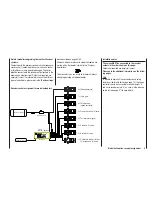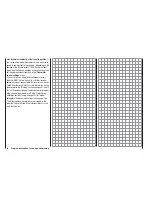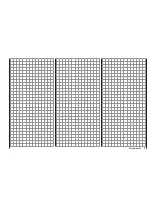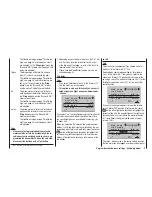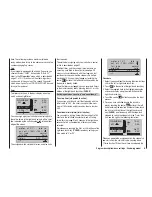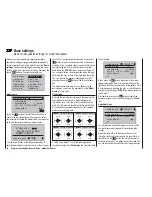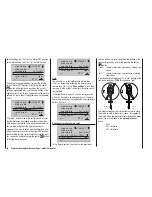
60
Program description: base settings - fi xed-wing model
timer does not stop, but continues to run so that you can
read off the time elapsed after reaching zero. To make
this clear, the over-run time is shown highlighted (black
background).
Sequence of sounds
30 sec. before zero: triple beep
single beep every two seconds
20 sec. before zero: double beep
single beep every two seconds
10 sec. before zero: single beep
single beep every second
5 sec. before zero: single beep every second at higher
rate
zero: longer beep; display switches to
inverse video
The “alarm timer” is reset by simultaneously touching
the
cd
or
ef
buttons of the right-hand touch-key
(
CLEAR
), once you have halted the timer.
Note:
A count-down timer is indicated in the basic display by
a fl ashing colon (:) between the minutes fi eld and the
seconds fi eld.
Phase 2, Phase 3 and Phase 4
You will automatically be in the “normal” fl ight phase 1
unless you have already assigned a switch to phases 2,
3 or 4.
Both the number and name of this fl ight phase are fi xed
permanently as “normal”, and cannot be changed. For
this reason the “normal” phase is simply concealed, i. e.
it is not displayed as phase 1.
10:01
2
phase 2
phase 3
phase 4
takeoff
landing
speed
–––
–––
–––
aile/flap
2aile
timer
It is also important to understand that the fl ight phases
have their own inherent priorities which need to be ob-
served, particularly when assigning individual switches.
The underlying scheme can be described as follows:
If all assigned fl ight phase switches are closed or
•
open, the “normal” fl ight phase is active.
If only one switch is closed, then the fl ight phase as-
•
signed to the currently closed switch is active.
If two switches are closed, then the fl ight phase with
•
the lower number is active.
For example, this would be phase 2, if one of the
switches assigned to phase 3 or 4 is also closed, or
phase 3, if the switches assigned to phases 3 and 4
are closed.
As a result you may wish to take the inherent phase
•
priorities into account when assigning names to the
fl ight phases; see below.
At the servo end the transition does not occur
•
“abruptly”, but with a fi xed transition period of about
one second.
Programming
When you select “phase 2”, “phase 3” or “phase 4” using
the arrow buttons
cd
of the left or right-hand touch-
key, the “Name” fi eld for that fl ight phase is already
framed.
If the default name does not seem appropriate, touch
the central
SET
button of the right-hand touch-key, and
the current setting is shown highlighted. Now use the
arrow buttons of the right-hand touch-key to select an
appropriate name from those available. Touch the
SET
button to conclude the input process.
Now press the
f
button of the left or right-hand touch-
key to move to the right-hand column at the bottom of
the screen, indicated by the switch symbol
, and
briefl y touch the central
SET
button. You can now assign
a switch to the phase as described on page 39. We
recommend one of the two three-position switches SW
4/5 or SW 6/7, in each case starting from the centre
toggle position.
For more information on fl ight phase programming
please refer to page 86, in the section entitled “
Phase
trim
”.
Receiver output
For maximum fl exibility in terms of receiver socket
assignment, the
mx-16
HoTT software provides the
means to swap over the servo outputs 1 to max. 8;
this is carried out on the second page of the “Receiver
output” sub-menu.
10:01
2
phase 2
phase 3
phase 4
takeoff
landing
speed
–––
timer
7
6
receiv out
Touch the central
SET
button of the right-hand touch-key
to move to the next page of the display. Here you can
assign the “control channels” for servos 1 … 8 to any
receiver output you wish to use. However, please note
Summary of Contents for mx-16 HOTT
Page 7: ...7 For your notes...
Page 37: ...37 For your notes...
Page 41: ...41 For your notes...
Page 45: ...45 For your notes...
Page 51: ...51 For your notes...
Page 55: ...55 For your notes...
Page 81: ...81 For your notes...
Page 103: ...103 For your notes...
Page 133: ...133 For your notes...
Page 141: ...141 For your notes...
Page 161: ...161 For your notes...
Page 173: ...173 For your notes...


